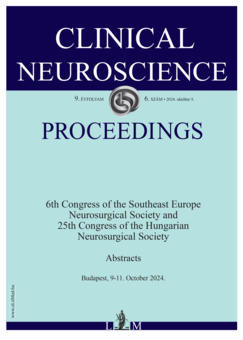Complications of stereotactic radiosurgery: The dark side of the Moon
MANJUL Tripathi1
2024. OKTÓBER 09.
Ideggyógyászati Szemle Proceedings - 2024;9(6)
MANJUL Tripathi1
2024. OKTÓBER 09.
Ideggyógyászati Szemle Proceedings - 2024;9(6)
Szöveg nagyítása:

Gamma knife radiosurgery (GKRS) is a popular radiosurgical tool for various benign and malignant intracranial pathologies. Our objective was to evaluate the spectrum of complications of GKRS, the timeline of adverse events, and the outcome following the radiosurgical intervention. We systematically searched for articles related to various complications using the following keywords: “Vascular complications”, “Gamma-knife”, “stereotactic”, “radiosurgery”, “complications”, “edema”, “vascular changes”, “malignancy”, and “alopecia”. The literature was separately evaluated for ‘early ‘(within 12 weeks of GKRS)’ or ‘delayed’ (after 12 weeks of GKRS) sequalae. We separately evaluated the relevant animal studies for literature analysis, and for the histopathological changes that take place after radiosurgery. Following the systematic analysis, 543 articles were evaluated. With the predetermined criteria, we identified 36 studies detailing 72 cases. Vascular complications, radiosurgery induced malignancy, radiation necrosis and radiation induced edema were the major reported complications. A delayed hemorrhage after a latency period was the most common complication while administering GKRS for arteriovenous malformations. A repeat radiosurgical intervention was identified as the significant factor responsible for delayed hemorrhage. Post-radiosurgery intratumoral hemorrhage was observed in meningiomas, vestibular schwannomas, pituitary adenomas, pineocytomas and cerebellar astrocytomas. Following the administration of single fraction stereotactic radiosurgery (SRS) for brain metastases, necrosis was observed in 5.2% patients at 6 months, in 17.2% at 12 months, and in 34% patient population at 24 months. Delayed occlusive or proliferative vasculopathy, malignancy, necrosis and edema are rare, albeit probable, complications that occur after GKRS. There are no definite identifiable markers for determining the probability of developing these complications. The risks of radiosurgery-induced complications are more in patients with a history of prior radiation therapy, a large tumor volume, and the usage of non-conformal dose plans. The risk of radiation-induced tumour formation after a single-function radiosurgery is very low and should not be used as a reason to choose alternative treatment strategies for appropriate patients. The clinician should explain these probable risks to the patient before considering GKRS as a treatment option.
Ideggyógyászati Szemle Proceedings
Despite evidence based institutional protocols being in place in many countries, aneurysmal subarachnoid hemorrhage (SAH) continues to be a major socio-economic burden with many open questions remaining regarding the optimal management of the affected patients.
Ideggyógyászati Szemle Proceedings
Arteriovenous malformation (AVM) is an anomaly of blood vessel formation. Numerous models have been established to understand the nature of AVM.
Ideggyógyászati Szemle Proceedings
Additive manufacturing has gained significant traction in industrial applications due to its high potential when it comes to manufacturing objects with complex geometry.
Ideggyógyászati Szemle Proceedings
Not only other surgical and robotic fields, but minimally invasive procedures in spine surgery have undergone significant development in recent times. A demand emerged from both surgeons and patients to develop and perform these types of surgeries in order to prevent biomechanical and surgical complications.
Ideggyógyászati Szemle Proceedings
Functional magnetic resonance imaging (fMRI) is crucial for presurgical language mapping in neurosurgery, helping identify eloquent brain regions to preserve during operations. Effective language mapping depends on advanced fMRI acquisition and detailed data analysis to ensure accurate clinical outcomes.
Ideggyógyászati Szemle Proceedings
Not only other surgical and robotic fields, but minimally invasive procedures in spine surgery have undergone significant development in recent times. A demand emerged from both surgeons and patients to develop and perform these types of surgeries in order to prevent biomechanical and surgical complications.
Ideggyógyászati Szemle Proceedings
Pleomorphic xanthoastrocytomas (PXA) are rare grade2, occasionally grade 3 astrocytic tumors according to the current WHO classification. PXAs account for less than 1% of all astrocytomas.
Ideggyógyászati Szemle Proceedings
Colloid cysts of the third ventricle typically manifest as regular round lesions situated between the foramens of Monroe, with diameters typically measuring a few millimeters. They are closely stuck to bilateral choroid plexuses of the frontal horns. Clinically, they may be incidental or, by obstructing cerebrospinal fluid (CSF) flow into the third ventricle, can lead to chronic or sudden intracranial hypertension.
Ideggyógyászati Szemle Proceedings
Since the initial implementation of deep brain stimulation (DBS) for essential tremor by Pollack and Benabid, it has emerged as the gold standard treatment over the past three decades. However, achieving successful outcomes still relies heavily on accurate planning and electrophysiological mapping of the Vim(ventral intermediate nucleus of thalamus).
Ideggyógyászati Szemle Proceedings
Pain is a physical experience that is transmitted from sensory nerve cells through the spinal cord to the brain, where the sensation of pain is registered. Each person experiences and endures pain in a different way.
Outcomes of stereotactic radiosurgical treatment for glomus jugulare tumors: a single center study of 49 cases
Radiosurgery for deep seated AVM’s
1.
2.
3.
4.
5.
Egészségpolitika
Hadiállapotként kezeli és így is reagál a kormány az egészségügy „rendezésére”1.
2.
3.
4.
5.